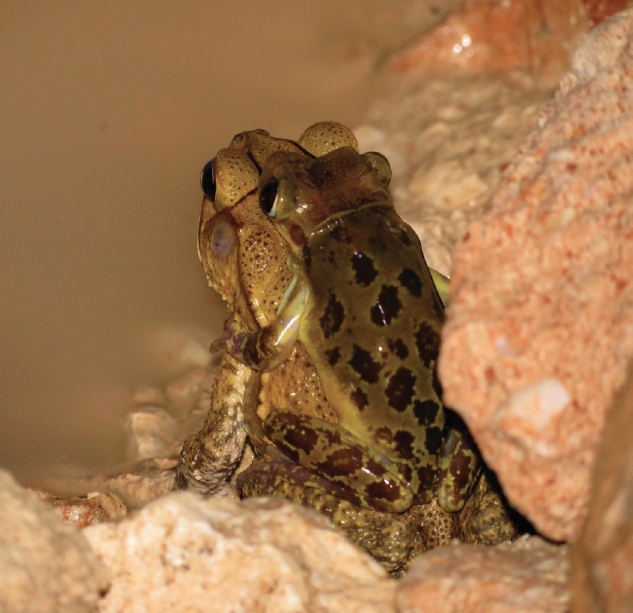The Yucatán casque-headed tree frog Triprion petasatus (Cope, 1856) is widely distributed in the Yucatán Peninsula, Mexico, Belize, and throughout El Petén, Guatemala, although its occurrence in Honduras has recently been called into question (Lee, 1996; McCranie, 2015; Frost, 2017). The Southern Gulf Coast toad Incilius valliceps (Wiegmann, 1833) ranges from central Veracruz, Mexico to northern Costa Rica on the Atlantic versant, and from the Isthmus of Tehuantepec to south-central Guatemala on the Pacific slope, with an isolated record for El Salvador (Oliver-López et al., 2009; Frost, 2017). Amplexus occurring between amphibians of different orders (Höbel, 2005a; Simović et al., 2014), families (Sodré et al., 2014; Clause et al., 2015; Bell & Scheinberg, 2016; Reilly et al., 2016), genera (Streicher et al., 2010; Kindermann, 2015; Marchant et al., 2015; Loc-Barragán et al., 2016), and species (Höbel, 2005b; Ceron & Zocche, 2016; Schalk, 2016) that overlap spatially and temporally has been documented previously, even if one of those involved is dead (Waterstrat et al., 2008; Müller, 2016), or both are males (Costa-Campos et al., 2016).
We found an axillary amplexus between a male T. petasatus and a male I. valliceps on 13 June 2015, at Pisté, Yucatán, Mexico (20.682085° N, -88.600571° W; WGS84; elev. 30 m; Fig. 1). Our observation occurred at 20:34 h at a temporary pond surrounded by secondary vegetation and dry forest. Only one other species of anuran, Smilisca baudinii (Duméril & Bibron, 1841), was observed to be active in the area. During courtship, the males normally call to attract conspecific females, and differences in vocalization frequencies help to reduce interspecific mating (Wells, 2007). Triprion petasatus and I. valliceps emit a very different vocalization: 2100 – 2300 Hertz (pulse frequency of 75 – 90 seconds, and duration of 350 milliseconds) and 1800 – 2000 Hertz (pulse frequency 40 – 50 seconds, 2 – 5 seconds duration), respectively (Lee, 1996). At the same time, T. petasatus males average 55 mm in snout-vent length (SVL) and females average 70 mm in SVL, whereas male I. valliceps average 73 mm in SVL and females average 88 mm in SVL (Lee, 1996). Therefore, the similarity in body size between T. petasatus females and male I. valliceps could have contributed to the lack of specific discrimination (Yu & Lu, 2013).
In areas with a marked dry season, like the northern Yucatán Peninsula (Torrescano-Valle & Folan, 2015), explosive reproductive events are commonplace where T. petasatus and I. valliceps congregate in temporary ponds to mate and oviposit, as we observed the night of the discovery, with several tens of individuals of both species congregated, and S. baudinii in lower numbers. Therefore, heterospecific and multiple amplexus, even between males, seems to be common among explosive breeders, due to the high number of individuals and an often male-biased sex ratio at the same site (Wogel et al., 2005), the short time for breeding (Hobel, 2005b), confusion of chemical signals (Mollov et al., 2010), and low selectivity toward females (Machado & Bernarde, 2011). To our knowledge, this is the first observation documenting this behavior between individuals of T. petasatus and I. valliceps, two common anuran species found in sympatry, and suggests that neither differences in morphology and vocalization help to completely prevent heterospecific amplexus.











 nueva página del texto (beta)
nueva página del texto (beta)



